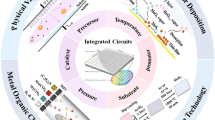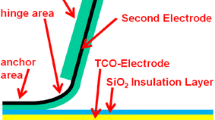Abstract
Heterogeneous integration of InP and GaSb on Si substrates holds a huge potential interest in near-infrared and mid-infrared optoelectronic devices. In this study, 2-inch 180-nm-thick InP and 185-nm-thick GaSb thin layers were successfully transferred onto the Si substrates to form high-quality and ultra-smooth InP/Si and GaSb/Si templates using molecular beam epitaxy (MBE) and the ion-slicing technique together with selective chemical etching. The relocation of the implantation-introduced damage in the sacrificial layer enables the transfer of relatively defect-free InP and GaSb thin films. The sacrificial layers were completely etched off by selective chemical etching, leaving ultra-smooth epitaxial surfaces with a roughness of 0.2 nm for the InP/Si template and 0.9 nm for the GaSb/Si template, respectively. Thus, the chemical mechanical polishing (CMP) process was not required to smooth the surface which usually introduces particles and chemical contaminations on the transferred templates. Furthermore, the donor substrate is not consumed and can be recycled to reduce the cost, which provides a paradigm for the sustainable and economic development of the Si integration platform.
Similar content being viewed by others
References
Keyvaninia S, Verstuyft S, van Landschoot L, et al. Heterogeneously integrated III-V/silicon distributed feedback lasers. Opt Lett, 2013, 38: 5434–5437
Hao Y, Xiang S Y, Han G Q, et al. Recent progress of integrated circuits and optoelectronic chips. Sci China Inf Sci, 2021, 64: 201401
Fujii T, Takeda K, Nishi H, et al. Multiwavelength membrane laser array using selective area growth on directly bonded InP on SiO2/Si. Optica, 2020, 7: 838
Carter A D, Urteaga M E, Griffith Z M, et al. Q-band InP/CMOS receiver and transmitter beamformer channels fabricated by 3D heterogeneous integration. In: Proceedings of IEEE MTT-S International Microwave Symposium, 2017. 1760–1763
Jonsson A, Svensson J, Wernersson L E. A self-aligned gate-last process applied to all-III-V CMOS on Si. IEEE Electron Device Lett, 2018, 39: 935–938
Wang R J, Vasiliev A, Muneeb M, et al. III-V-on-silicon photonic integrated circuits for spectroscopic sensing in the 2–4 µm wavelength range. Sensors, 2017, 17: 1788
Moutanabbir O, Gösele U. Heterogeneous integration of compound semiconductors. Annu Rev Mater Res, 2010, 40: 469–500
Phelan R, Byrne D, O’Carroll J, et al. Mid-infrared inp-based discrete mode laser diodes. In: Optoelectronic Devices. Cambridge: Cambridge University Press, 2019
Turner W J, Reese W E, Pettit G D. Exciton absorption and emission in InP. Phys Rev, 1964, 136: 1467–1470
Doerr C R. Silicon photonic integration in telecommunications. Front Phys, 2015, 3: 37
Guan H, Novack A, Galfsky T, et al. Widely-tunable, narrow-linewidth III-V/silicon hybrid external-cavity laser for coherent communication. Opt Express, 2018, 26: 7920–7933
Higurashi E. Heterogeneous integration based on low-temperature bonding for advanced optoelectronic devices. Jpn J Appl Phys, 2018, 57: 04FA02
Hjort K. Transfer of InP epilayers by wafer bonding. J Cryst Growth, 2004, 268: 346–358
Tong Q Y, Chao Y L, Huang L J, et al. Low temperature InP layer transfer. Electron Lett, 1999, 35: 341
Christiansen S H, Singh R, Gosele U. Wafer direct bonding: from advanced substrate engineering to future applications in micro/nanoelectronics. Proc IEEE, 2006, 94: 2060–2106
Levinshtein M, Rumyantsev S, Shur M. Handbook Series on Semiconductor Parameters. Singapor: World Scientific, 1996
Akahane K, Yamamoto N, Gozu S, et al. Heteroepitaxial growth of GaSb on Si(001) substrates. J Cryst Growth, 2004, 264: 21–25
Arpapay B, Suyolcu Y E, Çorapçıoğlu G, et al. A comparative study on GaSb epilayers grown on nominal and vicinal Si(100) substrates by molecular beam epitaxy. Semicond Sci Technol, 2020, 36: 025011
Yokoyama M, Yokoyama H, Takenaka M, et al. Ultrathin body GaSb-on-insulator p-channel metal-oxide-semiconductor field-effect transistors on Si fabricated by direct wafer bonding. Appl Phys Lett, 2015, 106: 073503
Singh R, Radu I, Scholz R, et al. Low temperature InP layer transfer onto Si by helium implantation and direct wafer bonding. Semicond Sci Technol, 2006, 21: 1311–1314
Lin J J, You T G, Wang M, et al. Efficient ion-slicing of InP thin film for Si-based hetero-integration. Nanotechnology, 2018, 29: 504002
Mazen F, Sollier S, Madeira F, et al. Fracture in epitaxial InP on Si for InGaAs on insulator fabrication via smart cutTM. In: Proceedings of the 21st International Conference on Ion Implantation Technology (IIT), 2016. 1–4
Clawson A R. Guide to references on III-V semiconductor chemical etching. Mater Sci Eng-R-Rep, 2001, 31: 1–438
Hjort K. Sacrificial etching of III-V compounds for micromechanical devices. J Micromech Microeng, 1996, 6: 370–375
Dier O, Lin C, Grau M, et al. Selective and non-selective wet-chemical etchants for GaSb-based materials. Semicond Sci Technol, 2004, 19: 1250–1253
Grzesik M, Vangala S R, Goodhue W D. Indirect wafer bonding and epitaxial transfer of GaSb-based materials. J Elec Materi, 2013, 42: 679–683
Bruel M. Application of hydrogen ion beams to silicon on insulator material technology. Nucl Instrum Method Phys Res Sect B-Beam Interact Mater Atoms, 1996, 108: 313–319
Feng X Q, Huang Y. Mechanics of smart-cut(r) technology. Int J Solids Struct, 2004, 41: 4299–4320
Martienssen W. Springer Handbook of Condensed Matter and Materials Data. Berlin: Springer, 2005
Aspnes D E, Studna A A. Dielectric functions and optical parameters of Si, Ge, GaP, GaAs, GaSb, InP, InAs, and InSb from 1.5 to 6.0 eV. Phys Rev B, 1983, 27: 985–1009
Georgiev N, Mozume T. Raman scattering analysis of InGaAs/AlAsSb short-period superlattices. Appl Surf Sci, 2000, 159: 520–527
Chen L C, Tyan S L, Wu M C. Raman scattering of InAs1−x−y SbxPy quaternary alloys. Jpn J Appl Phys, 1998, 37: 1365–1366
Cai L C, Chen H, Bao C L, et al. Raman spectroscopic studies of InAs epilayers grown on the GaAs (001) substrates. J Cryst Growth, 2003, 253: 112–116
Xu D P, Litvinchuk A P, Wang X, et al. Structure stability of short-period InAs/AlSb superlattices. J Cryst Growth, 2003, 251: 547–550
Milekhin A, Werninghaus T, Zahn D R T, et al. Raman and infrared spectroscopical investigation of the optical vibrational modes in GaSb/AlSb superlattices. Eur Phys J B, 1998, 6: 295–299
Qiao Z X, Yun S, He W Y, et al. Raman scattering of polycrystalline GaSb thin films grown by the co-evaporation process. Chin Phys B, 2009, 18: 2012–2015
Acknowledgements
This work was supported by National Key RD Program of China (Grant No. 2017YFE0131300), National Natural Science Foundation of China (Grant Nos. U1732268, 61874128, 61851406, 11905282), Frontier Science Key Program of CAS (Grant Nos. QYZDY-SSW-JSC032, ZDBS-LY-JSC009), Program of Shanghai Academic Research Leader (Grant No. 19XD1404600), Shanghai Youth Top Talent Program, Shanghai Sailing Program (Grant Nos. 19YF1456200, 19YF1456400), K. C. Wong Education Foundation (Grant No. GJTD-2019-11), and NCBiR within the Polish-China (Grant No. WPC/130/NIR-Si/2018).
Author information
Authors and Affiliations
Corresponding authors
Additional information
Jin T T and Lin J J have the same contribution to this work.
Rights and permissions
About this article
Cite this article
Jin, T., Lin, J., You, T. et al. Efficient heterogeneous integration of InP/Si and GaSb/Si templates with ultra-smooth surfaces. Sci. China Inf. Sci. 65, 182402 (2022). https://doi.org/10.1007/s11432-021-3398-y
Received:
Revised:
Accepted:
Published:
DOI: https://doi.org/10.1007/s11432-021-3398-y




